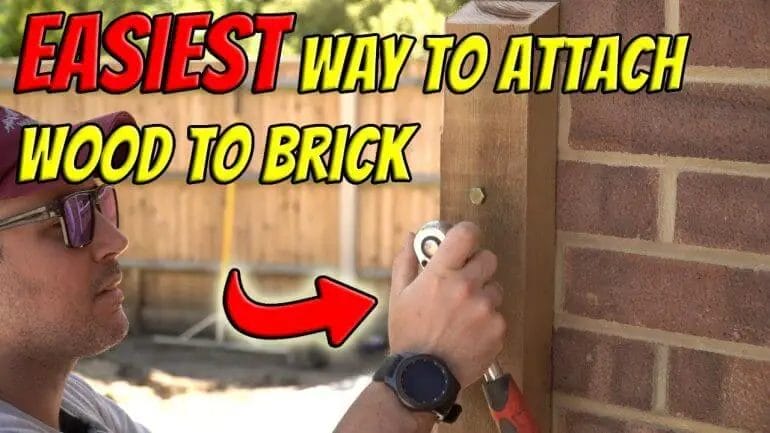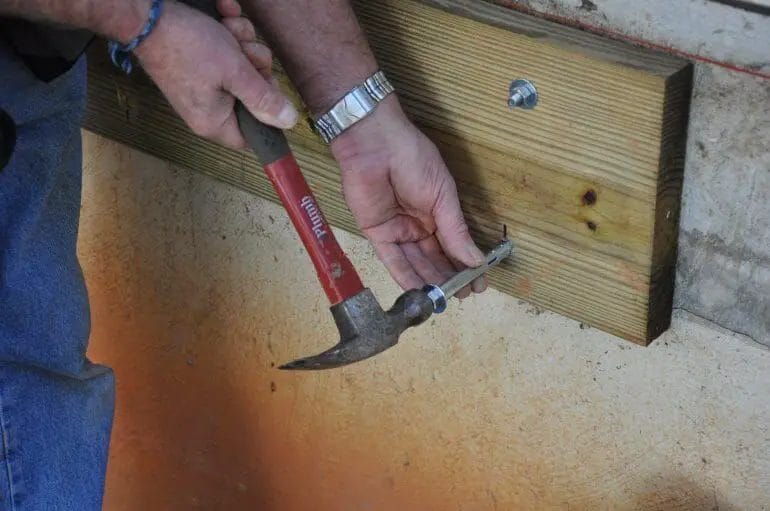Attaching wood to brick can be a challenging task, but with the right tools and techniques, it can be done effectively. There are several methods you can use, including using concrete screws, anchor bolts, or using a combination of construction adhesive and screws. It’s important to ensure a secure and stable attachment to prevent any potential accidents or damage. In this article, we will explore different techniques and provide step-by-step instructions on how to attach wood to brick, making your DIY project a success.

Preparing the Brick Surface for Wood Attachment
When it comes to attaching wood to a brick surface, proper preparation is key to ensuring a secure and durable installation. Before you begin the process, it’s important to gather all the necessary tools and materials you’ll need:

- Power drill with masonry drill bits
- Wood screws or masonry anchors
- Wood boards or panels
- Level
- Measuring tape
- Pencil or marker
- Safety goggles and gloves
Once you have everything ready, follow these steps to effectively prepare the brick surface for wood attachment:
1. Clean the Brick Surface
The first step is to thoroughly clean the brick surface. Use a stiff-bristle brush or a power washer to remove any dirt, debris, or loose mortar. This will ensure a clean and smooth surface for better adhesion.
2. Inspect for Damage
Inspect the brick surface for any signs of damage or deterioration. Look for cracks, chips, or loose bricks. If you notice any issues, it’s important to address them before proceeding with the wood attachment. Repair or replace any damaged bricks to ensure a solid foundation.
3. Mark the Attachment Points
Using a level, measure and mark the desired attachment points on the brick surface. Make sure the markings are evenly spaced and aligned. This will help ensure that your wood attachment is level and visually appealing.
4. Drill Pilot Holes
Using a power drill with the appropriate masonry drill bit, carefully drill pilot holes at the marked attachment points. The size of the drill bit should be slightly smaller than the diameter of the wood screws or masonry anchors you’ll be using. Be sure to wear safety goggles and gloves during this step.
5. Attach the Wood
Once the pilot holes are drilled, position your wood boards or panels against the brick surface. Align the attachment holes on the wood with the pilot holes you drilled. Securely attach the wood to the brick surface using wood screws or masonry anchors, depending on your specific needs and preferences.
6. Check for Level
After attaching the wood, use a level to ensure that it is straight and level. Make any necessary adjustments by loosening or tightening the screws or anchors. This step is essential for achieving a professional and visually pleasing result.
7. Seal and Finish
Finally, consider sealing and finishing the wood to protect it from the elements and enhance its appearance. Apply a waterproof sealant or a suitable wood finish, depending on the type of wood you’re using and the desired look. This will help prolong the lifespan of your wood attachment and maintain its aesthetic appeal.
By following these steps and taking the time to properly prepare the brick surface for wood attachment, you can ensure a secure and long-lasting installation. Remember to prioritize safety throughout the process and seek professional assistance if needed. With the right tools and techniques, you can achieve a beautiful and functional wood attachment to your brick surface.

Different Methods of Attaching Wood to Brick
When it comes to attaching wood to brick, there are several methods that can be used depending on the specific requirements and the desired outcome. Whether you are looking to install a shelf, build a pergola, or create a decorative feature, knowing the different methods available can help you choose the most suitable option for your project. In this section, we will explore some of the common methods used to attach wood to brick.
1. Adhesive Anchors
Adhesive anchors, also known as chemical anchors, are a popular and effective method for attaching wood to brick. These anchors typically consist of a resin-based adhesive that is injected into pre-drilled holes in the brick. When the adhesive cures, it forms a strong bond between the wood and the brick, providing a secure attachment. Adhesive anchors are ideal for lightweight applications and can be used for both indoor and outdoor projects.
2. Mechanical Anchors
Mechanical anchors, such as screws and bolts, provide a reliable and durable method of attaching wood to brick. To use mechanical anchors, holes are drilled into the brick, and then screws or bolts are inserted and tightened, securing the wood in place. This method is particularly useful for heavier applications or when a stronger connection is required. It is important to choose screws or bolts that are specifically designed for masonry applications to ensure a secure attachment.
3. Wall Plugs and Screws
Wall plugs, also known as anchors or expansion anchors, are often used in conjunction with screws to attach wood to brick. Wall plugs are typically made of plastic or nylon and are inserted into pre-drilled holes in the brick. As the screw is driven into the wall plug, it expands and creates a tight fit, anchoring the wood securely to the brick. This method is suitable for lightweight to medium-weight applications.
4. Angle Brackets
Angle brackets provide a sturdy and versatile method of attaching wood to brick. These brackets are typically made of metal and come in various sizes and configurations. They can be installed by drilling pilot holes into the wood and brick, and then attaching the brackets using screws or bolts. Angle brackets are commonly used for structural applications, such as attaching joists or beams to brick walls.
5. Construction Adhesives
Construction adhesives, such as epoxy or polyurethane-based adhesives, can be used to attach wood to brick. These adhesives provide a strong bond and are suitable for both indoor and outdoor applications. To use construction adhesives, the wood and brick surfaces need to be clean and free from dust and debris. The adhesive is then applied to one or both surfaces, and the wood is pressed firmly against the brick until the adhesive sets.
It is important to consider the specific requirements of your project and choose the method that best suits your needs. Factors such as the weight of the wood, the location of the attachment, and the desired level of permanence should be taken into account when selecting the appropriate method of attaching wood to brick. By choosing the right method and following the proper installation techniques, you can ensure a secure and long-lasting attachment.

Tips for a Secure and Long-Lasting Wood-to-Brick Attachment
When it comes to attaching wood to brick, it is important to ensure a secure and long-lasting connection. Whether you are building a deck, installing a door frame, or constructing a wall, following these tips will help you create a sturdy and reliable wood-to-brick attachment.
1. Choose the Right Fasteners
The type of fasteners you use plays a crucial role in the strength and durability of the wood-to-brick attachment. It is recommended to use corrosion-resistant fasteners, such as stainless steel screws or galvanized nails. These materials are less likely to rust or corrode over time, ensuring a secure connection.
2. Pre-drill Holes
Before attaching the wood to the brick, it is essential to pre-drill pilot holes. This will prevent the wood from splitting and make it easier to drive the fasteners into the brick. Use a masonry drill bit that matches the diameter of your chosen fasteners and drill the holes at appropriate intervals along the wood-to-brick connection.
3. Use Anchor Screws or Bolts
For heavy-duty applications or when extra strength is required, consider using anchor screws or bolts. These fasteners provide a more secure attachment by expanding inside the brick, creating a stronger connection. Be sure to follow the manufacturer’s instructions for proper installation.
4. Apply Construction Adhesive
In addition to using fasteners, applying construction adhesive to the wood-to-brick connection can further enhance its strength. Apply a generous amount of adhesive to the back of the wood piece before pressing it against the brick surface. This will create a bond that adds stability and reduces the risk of the attachment becoming loose over time.
5. Allow for Expansion and Contraction
Wood and brick materials can expand and contract with temperature and moisture changes. To accommodate this movement and prevent damage to the attachment, it is crucial to leave a small gap between the wood and the brick. This gap allows for natural shifting without putting excessive stress on the connection.
6. Protect the Wood
Wood in direct contact with brick can be susceptible to moisture damage. Apply a layer of weatherproofing sealant or paint to the wood surface before attaching it to the brick. This protective barrier will help prevent water penetration, prolonging the life of the wood and ensuring a more secure attachment.
7. Regular Maintenance
To ensure the longevity of the wood-to-brick attachment, regular maintenance is essential. Inspect the connection periodically for any signs of wear, damage, or looseness. Replace any damaged fasteners or deteriorated wood promptly to maintain the structural integrity and security of the attachment.
By following these tips, you can achieve a secure and long-lasting wood-to-brick attachment. Remember to choose the right fasteners, pre-drill holes, consider using anchor screws or bolts for heavy-duty applications, apply construction adhesive, allow for expansion and contraction, protect the wood, and perform regular maintenance. These measures will contribute to the overall strength and reliability of the attachment, providing peace of mind for years to come.
Common mistakes to avoid when attaching wood to brick
Attaching wood to brick can be a challenging task if not done correctly. Whether you are building a deck, installing a door frame, or creating a shelving unit, it is important to avoid common mistakes that can compromise the structural integrity and longevity of the attachment. In this section, we will discuss some of the most common mistakes to avoid when attaching wood to brick.
1. Not Preparing the Surface
One of the most common mistakes is failing to properly prepare the surface of the brick before attaching the wood. It is important to ensure that the brick surface is clean, dry, and free from any loose debris or paint. Use a wire brush or a power washer to remove any dirt or loose material, and allow the surface to dry completely before proceeding.
2. Using Incorrect Fasteners
Choosing the right fasteners is crucial when attaching wood to brick. Using the wrong type of fasteners can lead to weak attachments that may fail over time. It is important to use masonry anchors or screws specifically designed for attaching wood to brick. These fasteners are designed to provide a secure grip in masonry materials and prevent them from pulling out.
3. Improperly Drilling Holes
Drilling holes in the brick is necessary to insert the fasteners. However, drilling holes incorrectly can weaken the structure and cause the brick to crack or split. It is important to use a masonry drill bit that is the correct size for the fasteners being used. Additionally, make sure to drill the holes straight and at the proper depth to ensure a secure attachment.
4. Over-tightening Fasteners
While it is important to ensure that the fasteners are securely tightened, over-tightening them can lead to damage. Over-tightening can cause the wood to split or crack, and it may also strip the threads on the fasteners or cause them to break. Use a torque wrench or screwdriver with a clutch to avoid over-tightening and to ensure that the fasteners are tightened to the appropriate level.
5. Neglecting Moisture Protection
When wood is attached to brick, it is important to incorporate moisture protection measures to prevent water damage. Moisture can seep into the attachment point and cause the wood to rot or the brick to deteriorate over time. Applying a waterproof sealant or using a moisture barrier between the wood and the brick can help protect against moisture infiltration.
6. Not Allowing for Expansion and Contraction
Wood and brick have different rates of expansion and contraction due to changes in temperature and humidity. Failing to account for this can lead to structural issues over time. It is important to leave a small gap between the wood and the brick to allow for movement. Using spacers or shims can help create this gap and prevent the wood from warping or cracking.
7. Lack of Structural Support
When attaching wood to brick, it is important to provide proper structural support to prevent sagging or failure. Ensure that the wood is securely attached to load-bearing points on the brick, such as studs or joists. Additionally, consider using reinforcement techniques such as adding additional brackets or supports to distribute the weight evenly.
In summary, when attaching wood to brick, it is important to properly prepare the surface, use the correct fasteners, drill holes correctly, avoid over-tightening, protect against moisture, allow for expansion and contraction, and provide adequate structural support. By avoiding these common mistakes, you can ensure a secure and long-lasting attachment between wood and brick.
FAQs
1. How do I attach wood to brick?
To attach wood to brick, you can use either screws with wall anchors or masonry screws. Drill pilot holes into the wood, then use a masonry bit to drill corresponding holes in the brick. Insert the wall anchors or screws into the holes and tighten until secure.
2. What tools do I need to attach wood to brick?
To attach wood to brick, you will need a drill, a masonry bit, screws with wall anchors or masonry screws, and a screwdriver or drill bit for driving the screws into the brick.
3. Are there any special considerations when attaching wood to brick?
Yes, it is important to consider the weight of the wood and the load it will bear. Additionally, make sure to choose the appropriate screws or wall anchors based on the type of brick and the size of the wood being attached.
Conclusion
In conclusion, attaching wood to brick can be accomplished using various methods and techniques. One popular method is using masonry screws or anchors, which provide a secure attachment. Pre-drilling holes in the wood and brick will ensure proper alignment and prevent splitting or cracking. Additionally, construction adhesives designed for both wood and masonry can be used for a strong and durable bond. It’s important to consider the weight of the wood and choose appropriate fasteners or adhesive strength accordingly. Whether you’re installing a shelf, a mantel, or any other wooden structure on a brick wall, following these steps will help you achieve a secure and long-lasting attachment.
Remember to prioritize safety precautions and wear protective gear such as goggles and gloves when working with power tools or adhesives. Regularly inspect the attachment for any signs of damage or weakening, and make necessary repairs as needed. With the right tools, techniques, and materials, you’ll be able to successfully attach wood to brick and enhance the aesthetics of your space while adding functionality.